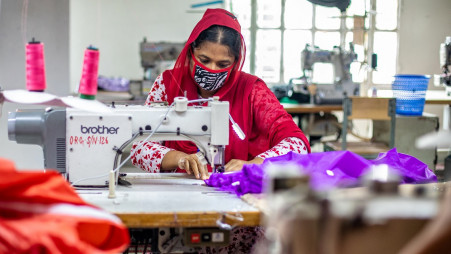Only a recovery plan or something similar from the government can help SMEs survive and sustain their business. And if SMEs survive, Bangladesh’s garment industry will surely flourish in the years to come.
An RMG employee in a garment factory. Photo: Mumit M/TBS
“>

An RMG employee in a garment factory. Photo: Mumit M/TBS
Bangladesh’s garment industry is facing a tough time after the Covid-19 pandemic. The country’s apparel exports to the United States, our largest export destination as a country, declined by up to 21.77% between January and August of the financial year 2023-24.
The United States imported $5.18 billion worth of clothing from Bangladesh in the first eight months of 2023, compared to $6.62 billion during the same period in 2022, according to data released by the Office of Textiles and Apparel (Otexa) of the United States Department of Commerce. .
It is worth mentioning here that Bangladesh is the third largest garment exporting country to the United States, after China and Vietnam. All major sources of U.S. apparel imports, including China, Vietnam, India, and Indonesia, also showed significant negative growth during the January-August 2023 period.
According to Otexa data, overall U.S. clothing imports from the world decreased by 22.77% during this time of year, compared to the same period in 2022.
The reason for this sharp decline in US clothing imports is obvious: inflation which has hit ordinary US citizens hard, who have focused on purchasing basic necessities while cutting their budgets for new clothes.
We also don’t have good news from the European Union, which as a region is our largest clothing export destination. Bangladesh’s clothing exports to the EU decreased by 12.69% in the first half of 2023, totaling €9.06 billion, compared to €10.37 billion in the same period of 2022.
This decline can also be attributed to a reduction in demand for clothing due to high inflation and a silent recession affecting all 27 EU countries.
Although Bangladesh’s garment exports to the EU during the July-September period of the financial year 2023-24 recorded a growth of 11.47 per cent compared to the same period of the previous financial year, according to the Export Promotion Bureau (EPB), we cannot rely on them. be a promising sign.
In the last financial year, we celebrated Eid-ul-Azha in July, and during the long Eid holidays, our clothing exports always remain low. Therefore, the comparison between exports from July-September 2022 and July-September 2023 is not a true reflection of the situation.
There is little hope that the situation will change in the near future, due to the current global economic instability. The war between Russia and Ukraine shows no sign of ending. Furthermore, the recent Israeli-Palestinian situation will only add salt to this economic wound from which the whole world is suffering.
Small and medium-sized garment factories in Bangladesh have faced the greatest difficulty in navigating this difficult period. We must not forget that these SMEs constitute the foundation on which the citadel of our industry was built. It is therefore of utmost importance that we provide support to these small and medium-sized garment factories now.
The world will return to normal sooner or later. Clothing orders will also rebound. But if we cannot help these SMEs exist in these tumultuous times, our vision of reaching $100 billion in apparel exports by 2030 will be a pipe dream.
Times are tough for all factories, whether large, medium or small. But the big players can sometimes face the storm, which destroys the media and sweeps away the small factories; because clothing is a capital-intensive business.
We have seen how the government’s recovery plan during the pandemic has helped factories sustain themselves and stay in business. The current situation is no less serious than the pandemic.
Therefore, only a stimulus package or something similar from the government can help SMEs survive and sustain their business. And if SMEs survive, Bangladesh’s garment industry will surely flourish in the years to come.
Abdallah Hil Rakib. Illustration: SCT
“>

Abdallah Hil Rakib. Illustration: SCT
Abdallah Hil Rakib is the general manager of Team Group. He is the Director of Bangladesh Garment Manufacturers and Exporters Association (BGMEA).

